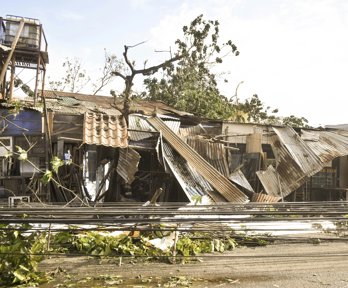Key words
-
Disaster
-
Disaster Management
-
Geology
-
Hazard
-
Landslide
-
Mitigation
-
Typhoon
Key topics and themes
-
Disaster management is complex and is a blend of economic, political and religious factors
-
Human impact contributes to the severity of disasters
-
The response of the Taiwanese Government was not adequate during and after Typhoon Morakot (2009)
-
Taiwan is highly susceptible to natural hazards, including flooding, tectonic movement, landslides and typhoons
Key Questions
-
What can be done to improve disaster management in the rural, mountain communities of Taiwan?
-
How do human and physical factors combine in the anatomy of a disaster?
Summary
Christopher Knight, Glen Burgin and Dr Yung-Fang Chen’s research was entitled ‘Living with typhoons: Disaster management in rural Taiwan.’
Typhoon Morakot was an extreme meteorological event that affected the Philippines, Taiwan and China in August 2009. It was the most destructive typhoon to impact Taiwan in history, its 140km (85 mph) winds resulting in 460 fatalities and $110 billion worth of damage. A primary lesson from Typhoon Morakot was that isolated mountain communities such as those in the Namasia and Maolin valleys in Taiwan were relatively unprepared for major typhoons. The pre-disaster hazard mitigation plans were not fully developed. Human vulnerability to typhoons was not given due consideration as there appeared to be a lack of understanding of how the physical features would interact with the human population during a major typhoon.
The research by Knight, Burgin and Chen assesses maps and determines the cause of the natural hazards and vulnerable features of the Namasia and Maolin valleys and also analyses housing reconstruction projects and the organisational structure of the Taiwanese disaster management system. Shelter and settlement strategies emerged as key factors to determine the satisfaction rates of affected residents after a disaster. Taiwanese typhoon mitigation plans, response methods and the likely impacts of typhoons on rural communities in mountainous southern Taiwan are analysed in detail. It also records through one to one interviews, questionnaires and conversations the perceptions of some of those who remain in the valleys during typhoons and those whose responsibility it is to develop and apply typhoon mitigation plans in the area.
Location
The location of this research project is the Namasia and Maolin valleys of southern Taiwan. They are both located in the north-eastern part of Kaoshiung Municipality, Taiwan. Both valleys are located in the Central Mountain Range. This range, consisting primarily of metamorphic rock, is boarded by the Western Foothills on the west and the Eastern Coastal Range to the east. Both valleys are deeply incised into the Central Mountain Range and consist of a large geological unit named the Lushan Formation. The valleys are mountainous and populated mainly by Taiwanese Aboriginals of which the majority belong to the Bunan tribe (with a substantial Tsou minority). Most residents are Christian.
Aims of the research
-
To examine the likely impacts of typhoons on rural communities in mountainous southern Taiwan
-
To assess the effectiveness of associated disaster preparedness and crisis response measures
Research techniques used
-
Questionnaires
-
Interviews
-
Geo-hazards mapping
Outcomes of the research
-
Summary of the main causes, effects and human responses to Typhoon Morakot in August 2009
-
Evaluation of emergency responses by the government of Taiwan, including consideration of the resettlement plans of those displaced after the disaster
-
National and local recommendations in order to improve disaster management in the future
About the author
David Rogers was, until recently, Curriculum Leader: Geography at Priory School Specialist Sports College in Portsmouth. He is a Chartered Geographer (Teacher), Regional Subject Advisor for the CfBT Trust and also a member of the Geography Collective. David sits on the GA’s Secondary Phase committee and also helps to edit their magazine. David has won several awards for his work in the geographical community. He has been involved in presenting and attending numerous CPD opportunities, and has also been filmed for Teachers TV.
The researchers
Christopher Knight is a graduate student from The University of Portsmouth, where he passed the MSc. Crisis and Disaster Management programme with merit. Dr Yung-Fang Chen is Senior Lecturer at Coventry University. She is also Director of the Centre for Disaster Management Applied Research Group. Glen is a recent graduate of Portsmouth University's, Geological and Environmental Hazards Masters programme.



